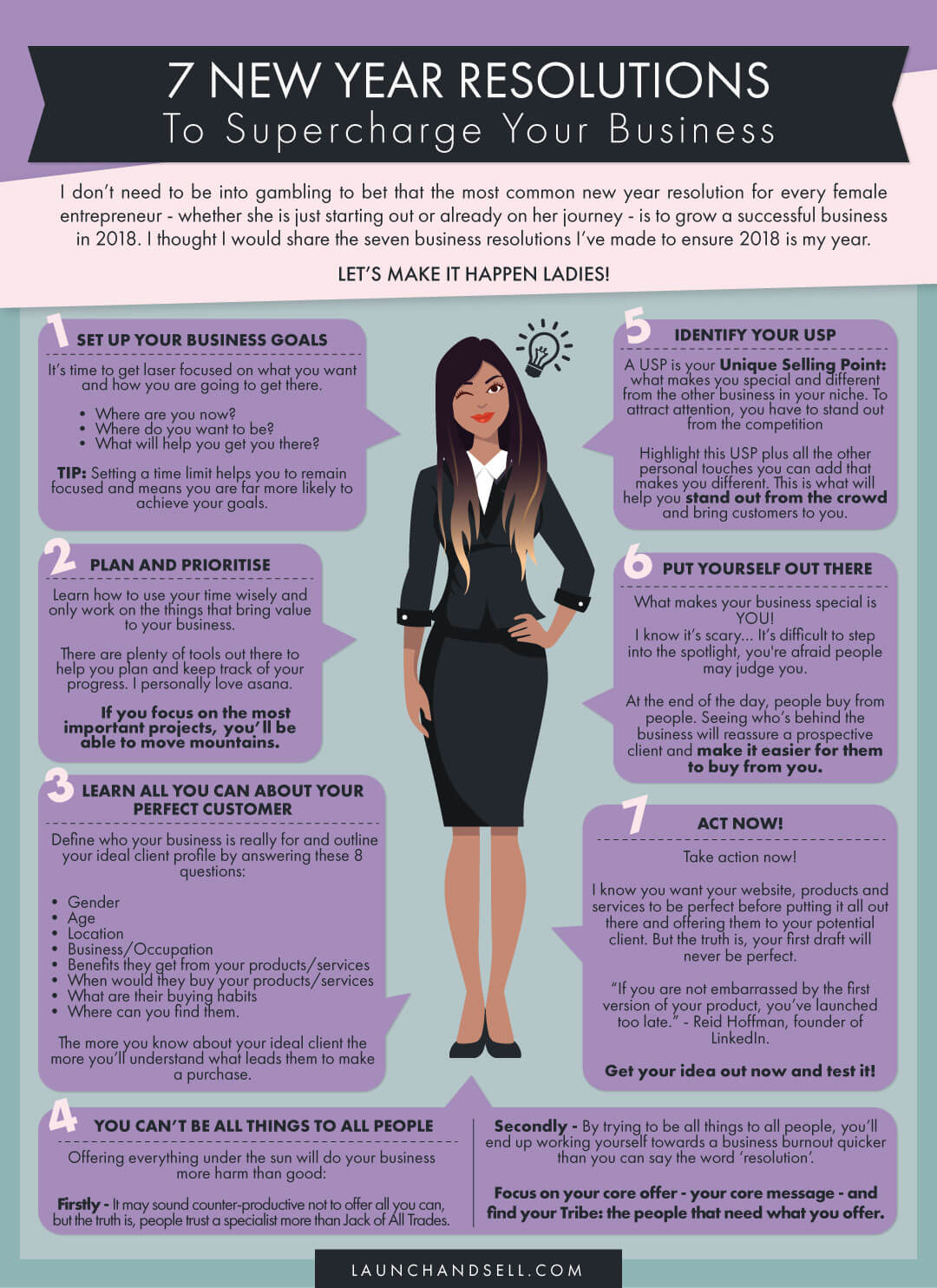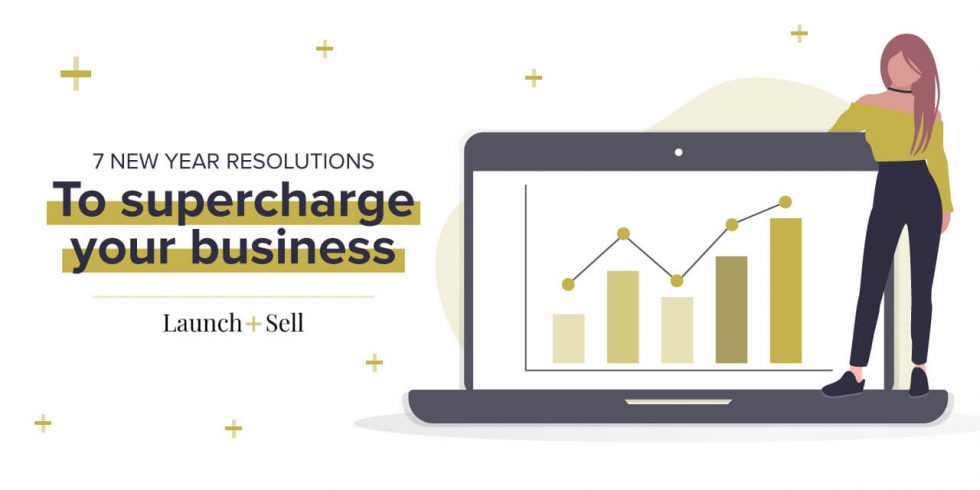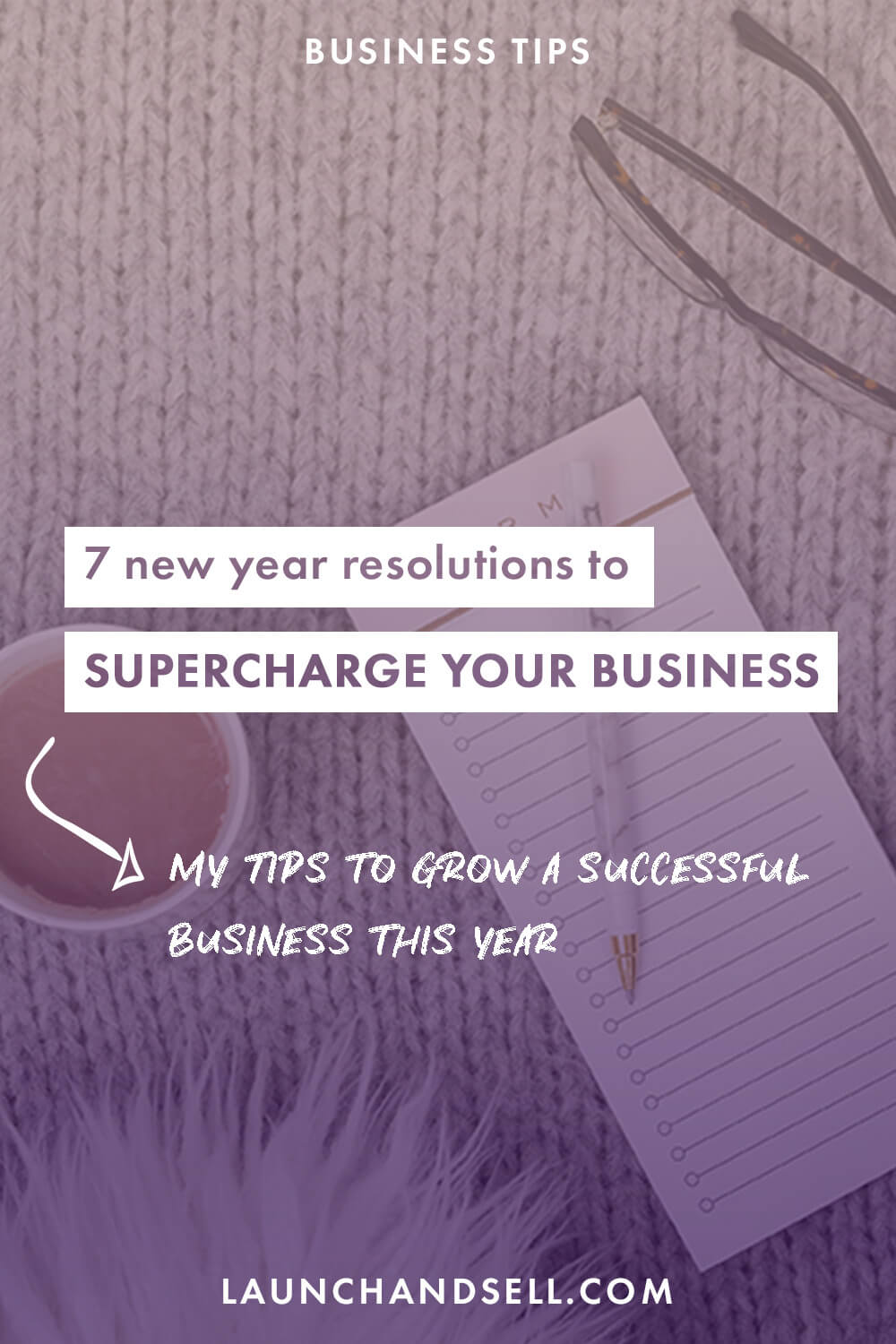As the start of another year rolls around, we are no stranger to the concept of new year resolutions. The promises we make to ourselves usually involve shedding that extra Christmas weight by hitting the gym and eating healthily. However, January is also a time for small business owners to reflect on the past year and start to put new goals in place.
I don’t need to be into gambling to bet that the most common new year resolution for every female entrepreneur – whether she is just starting out or already on her journey – is to grow a successful business in 2018.
With twelve months stretched out in front of you, how are you going to ensure you supercharge your business? To help you answer that question, I thought I would share the seven business resolutions I’ve made to ensure 2018 is my year.
Let’s make it happen ladies!
Don’t have the time to read it all? Jump directly to the Infographics 😉
1. Set up your business goals
Defined goals will allow you to move forward whilst not losing perspective of what you really want.
It’s time to get laser focused on what you want and how you are going to get there. Start by asking yourself these three simple questions:
- Where are you now?
- Where do you want to be?
- What will help you get you there?
Write out your answers in as much detail as you can. These will form the basis of your business goals and help you to remain motivated throughout the year.
Once you have a list of what you want to achieve, it’s time to put dates against everything. Setting a time limit helps you to remain focused and means you are far more likely to achieve your goals.
Setup a document that acts as a timeline with milestones you want to hit along the way. Breaking down your goals into these smaller steps will help you to keep track of how far you’ve come and celebrate your achievements.
2. Plan and prioritise
In business, it’s really important you plan and prioritise. Good project management is the key to optimising your time and achieving more. As an entrepreneur our most precious asset is time. You need to learn how to use your time wisely and only work on the things that bring value to your business.
There are plenty of tools out there to help you plan and keep track of your progress. I personally love Asana. It allows you to create projects, organise them and divide them into sub-tasks that you can mark as complete once you’ve done them.
If you focus on the most important projects, you’ll be able to move mountains.
3. Learn all you can about your perfect customer
Marketing is the key to your success and a good marketing strategy is a targeted one.
Targeted to who? I hear you ask.
It’s time to define who your business is really for: who are the people that need your product or service? How will you make sure they will be interested in your content? Focus on these people and target your marketing towards them.
To help you get started, outline your ideal client profile by answering these 8 questions:
- Gender
- Age
- Location
- Business/Occupation
- Benefits they get from your products/services
- When would they buy your products/services
- What are their buying habits
- Where can you find them.
The more you know about your ideal client the more you’ll understand what leads them to make a purchase. Use all of this information to create efficient, targeted marketing that will position you as an expert and make your product irresistible to your ideal client at the moment they are ready to make a purchase.
4. You can’t be all things to all people
The temptation is strong to say yes to every opportunity that comes your way. Some clients will always ask if you do more and you’ll find yourself nodding in the hopes that it will broaden your skills and widen your potential pool of clients.
However, offering everything under the sun will do your business more harm than good for two reasons:
Firstly – it may sound counter-productive not to offer all you can, but the truth is, people trust a specialist more than Jack Of All Trades.
Secondly – by trying to be all things to all people, you’ll end up working yourself towards a business burnout quicker than you can say the word ‘resolution’.
What’s more important is to focus on your core offer – your core message – and find your Tribe: the people that need what you offer. That way, you can target your marketing to address your ideal customers and see dramatically increased results.
There, doesn’t that feel like a weight lifted from your shoulders?
5. Identify your USP
What is USP? I’m glad you asked.
A USP is your Unique Selling Point: what makes you special and different from the other business in your niche. To attract attention, you have to stand out from the competition
My USP is simple: I offer great web design with no tech headaches combined with top notch customer service.
The best advice I can give you here is to try not to compete against people, companies or things you know you can’t win against.
For example, a big company may offer a 24/7 support service via a call centre. As a small business, you won’t be able to compete with that. However, what you can do is offer a very personalised service with direct access to the owner of the company – that’s you!
Highlight this USP plus all the other personal touches you can add that makes you different. This is what will help you stand out from the crowd and bring customers to you.
6. Put Yourself Out There
I know this one makes a lot of self-employed business owners wince, but it really is crucial to your success.
What makes your business special is YOU!
You may be offering a service that has been done before, so the only way to stand out from your competitors is to show your potential customers who you are. Use your words, include a lot of eye-catching pictures, record a few videos or Facebook or Instagram Lives: anything you can to showcase your story and who sits behind the brand you’ve created.
I know it’s scary… It’s difficult to step into the spotlight and blow your own trumpet, plus, you’re afraid people may judge you.
At the end of the day, people buy from people. Seeing who’s behind the business will reassure a prospective client and make it easier for them to buy from you. Showing a personal side to your product or service can work especially well for you if you are offering a solution to a problem you have personally overcome. If you can speak from a voice of experience and share your knowledge, you will find that you can build trust with your audience and a reputation as an expert in your field.
7. Act now!
Last, but definitely not least, is the most important of all the resolutions:
Take action now!
I know you want your website, products and services to be perfect before putting it all out there and offering them to your potential client. But the truth is, your first draft will never be perfect. You’ll need several trials and a lot of feedback from your customers to refine your offer and perfect your marketing strategy so you’re being seen by your ideal audience.
“If you are not embarrassed by the first version of your product, you’ve launched too late.” – Reid Hoffman, founder of LinkedIn.
Get your idea out now and test it! Think of the first time you hit publish as the dress rehearsal. Without that, you won’t have the opportunity to iron out the creases and present an ever better level of service than before.
What are you waiting for? It’s easier to improve on something that’s already being tested than it is to start from scratch.
Setting your 2018 business goals
I hope that sharing my seven business resolutions encourages you to start the year on a great note. Being clear on your own goals will allow you to take your business to the next step.
Let 2018 be the year your business booms.
What steps will you take to clarify your goals and make sure you achieve them? I’d love to know if I’ve inspired you to take action. Let me know by leaving me a comment.
Share with a female entrepreneur who you know could use a business goal setting boost!
Love it? Pin it!






Add a Comment